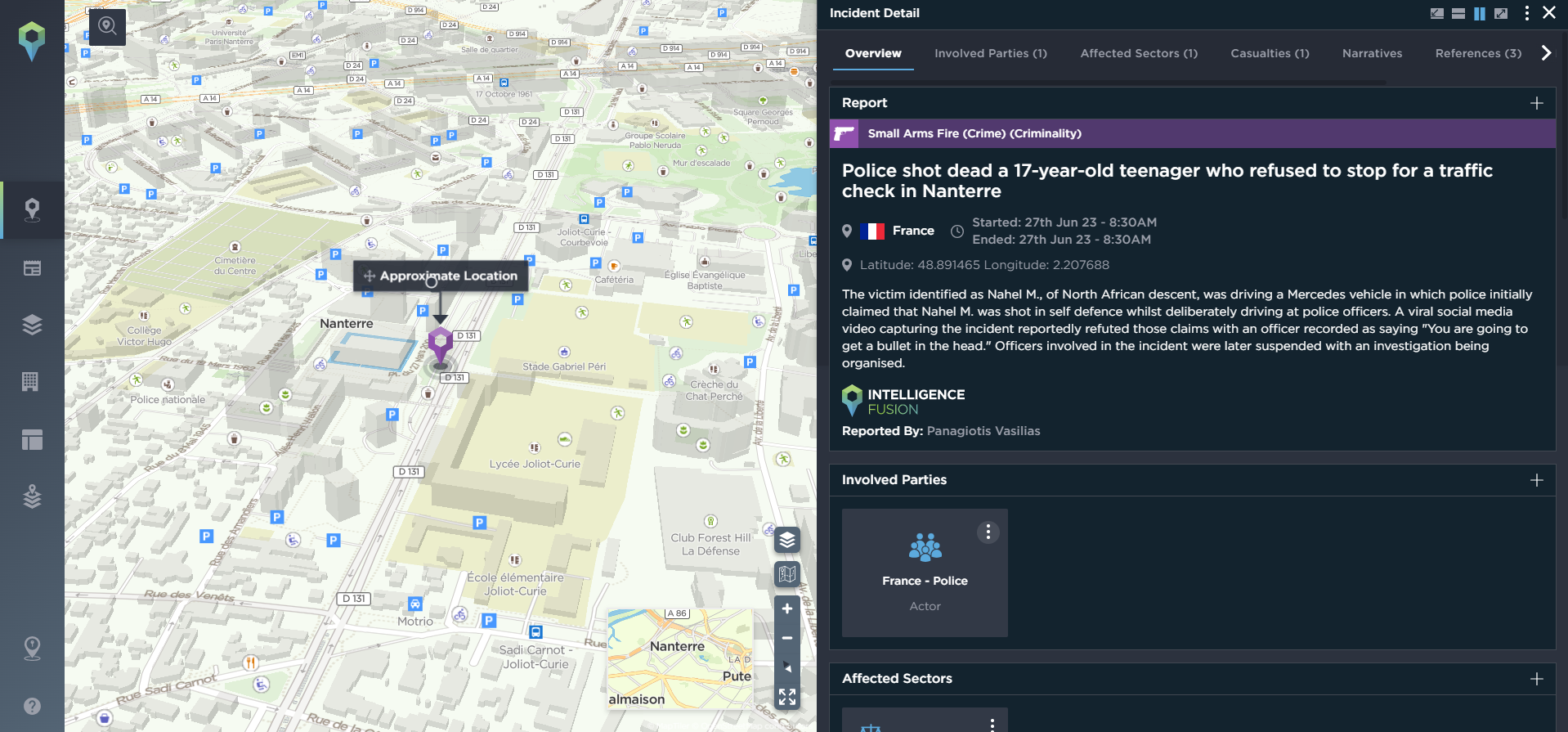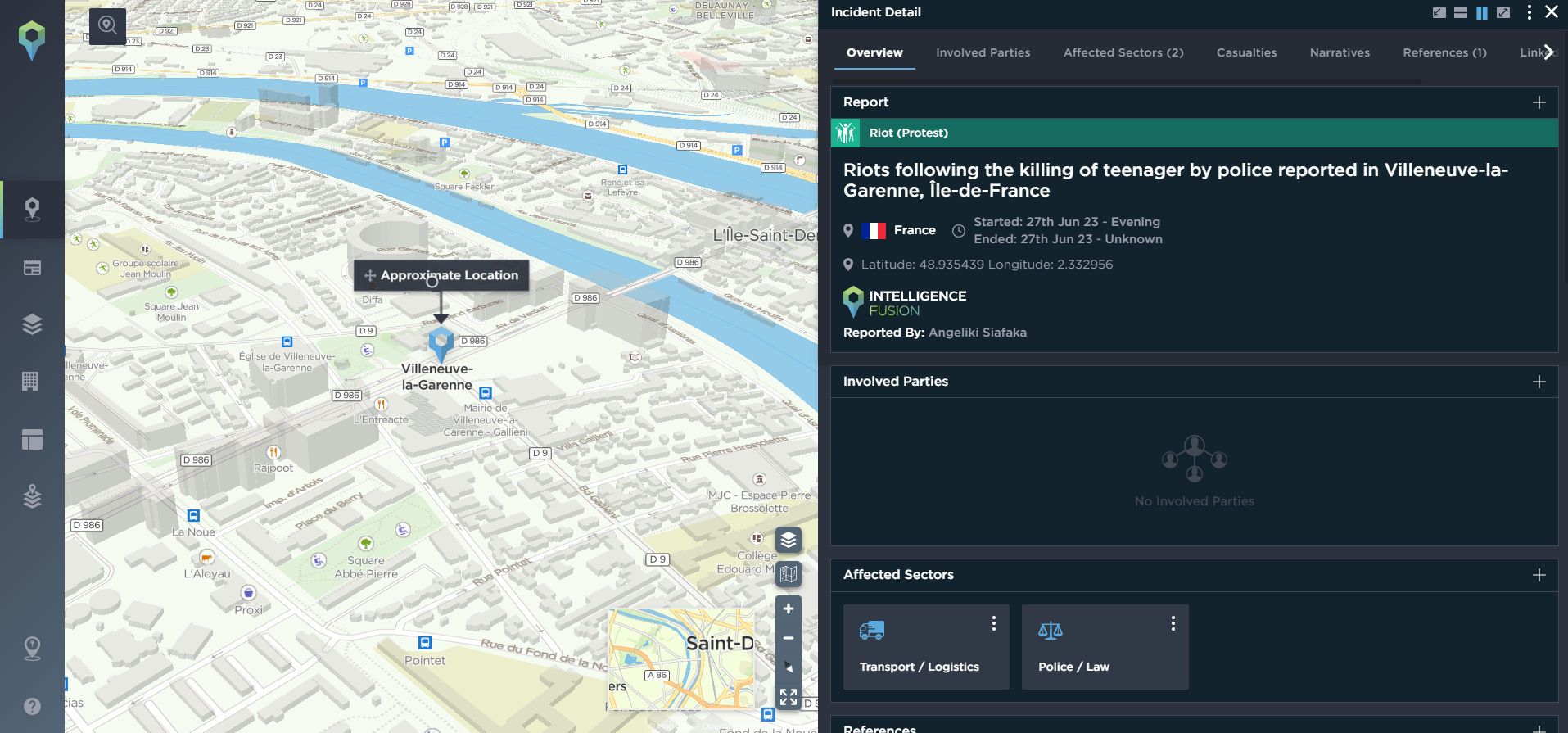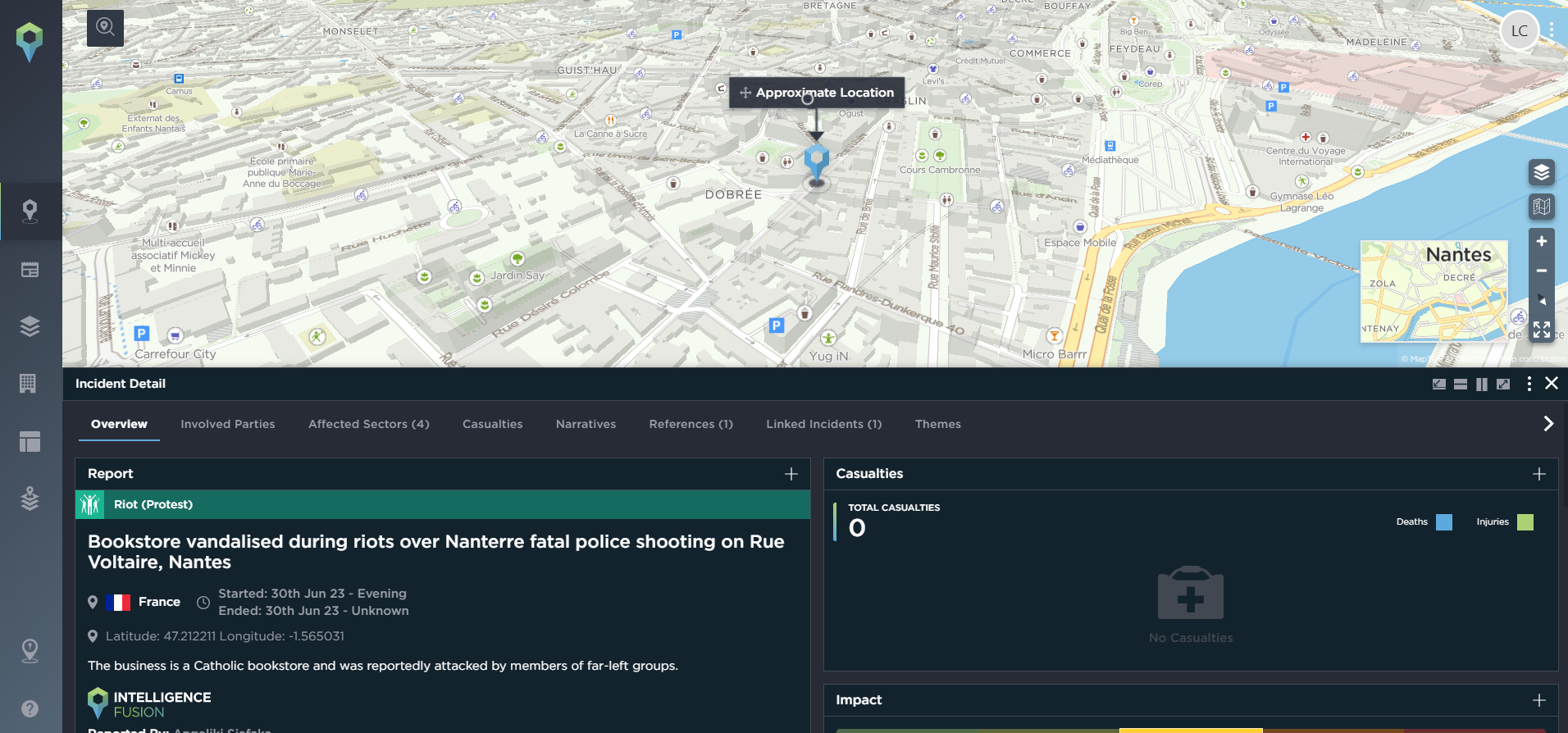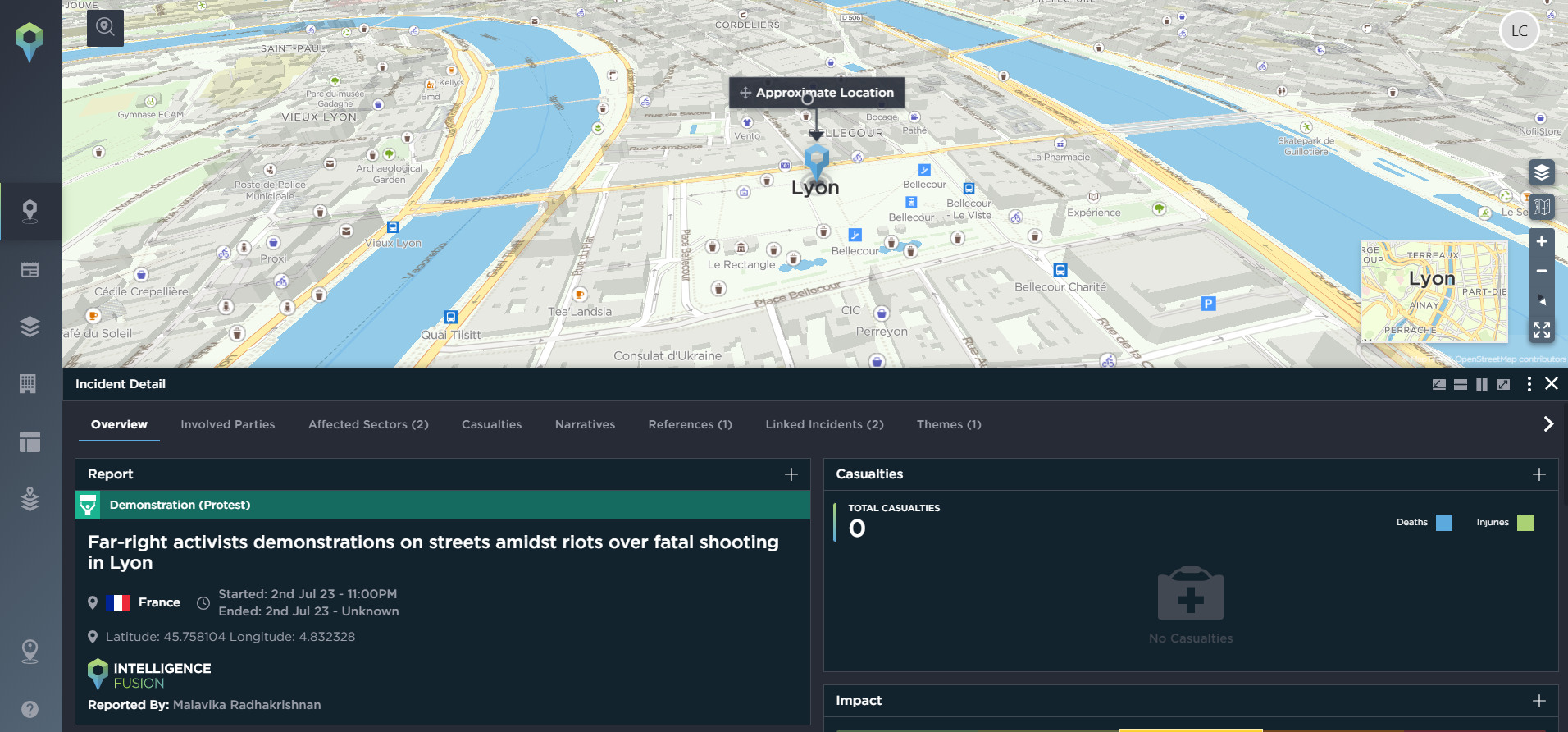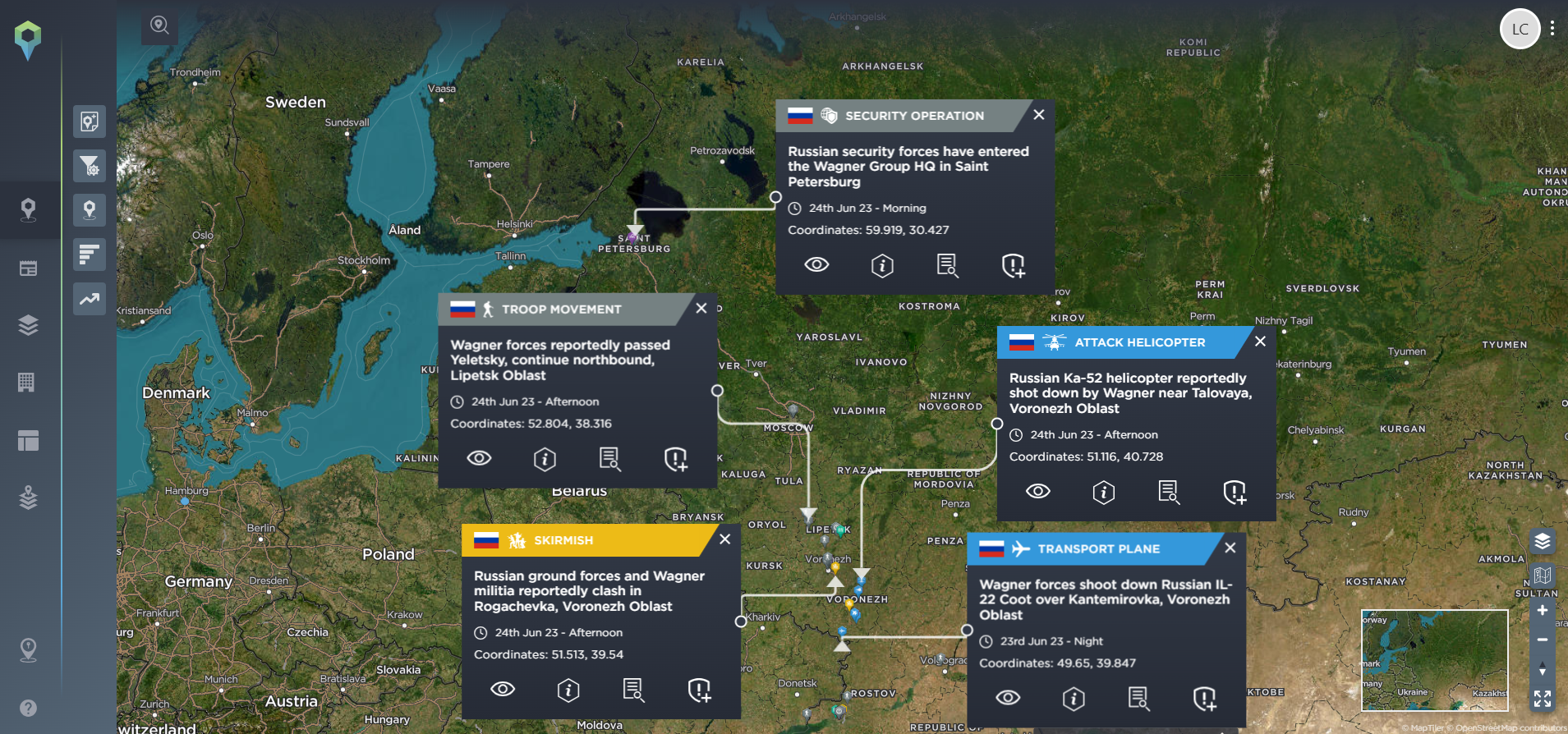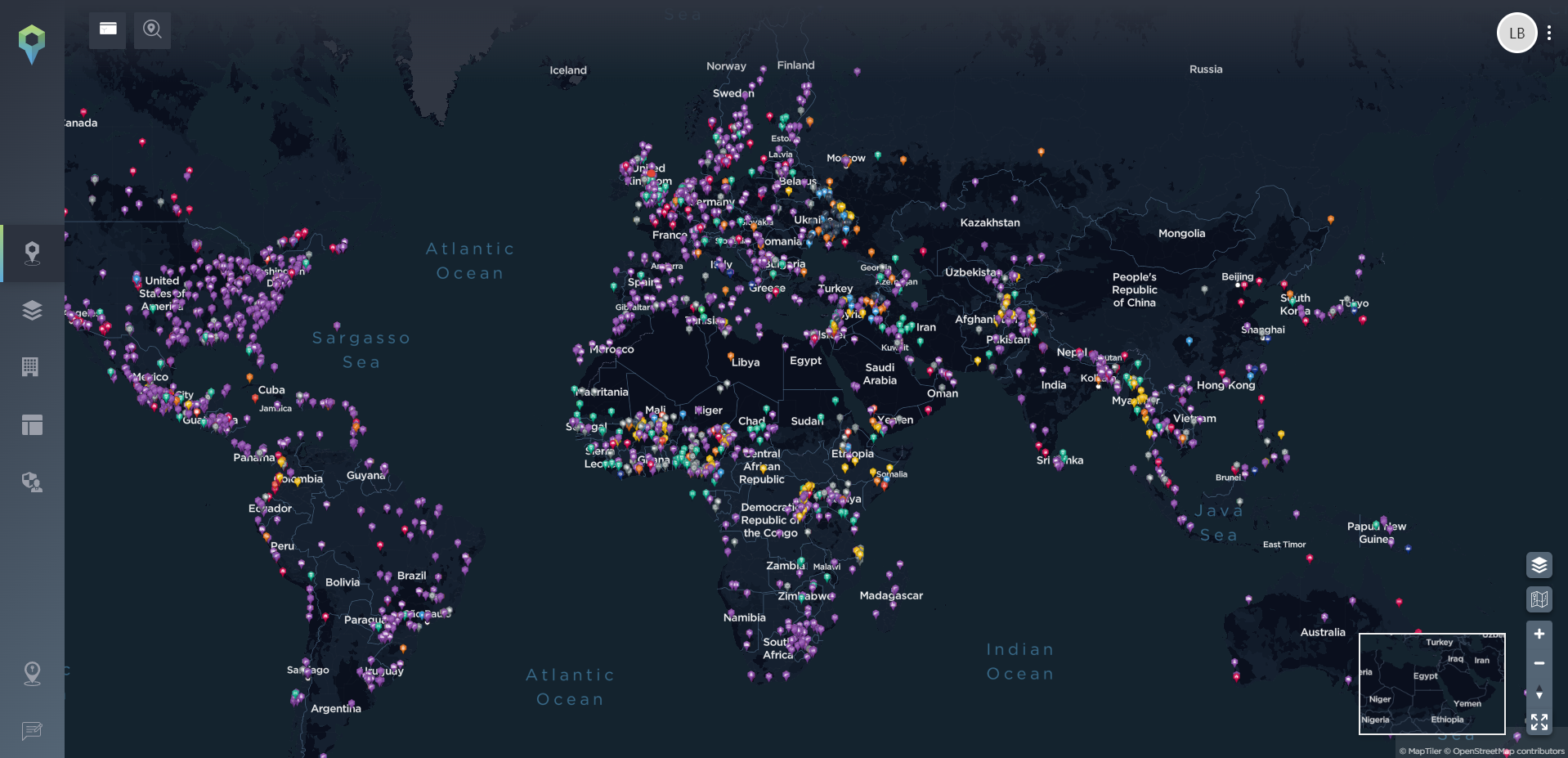Unrest in France: Understanding the Causes and Consequences of the Ongoing Riots
In recent weeks, the streets of France have become engulfed in a storm of unrest following the death of Nahel Merzouk.
What initially started as a localized incident has rapidly transformed into a nationwide wave of protests, demonstrations and violence. The repercussions of Nahel Merzouk’s death have ignited deep-seated anger among the French population, exposing underlying issues around race and inequality that have long plagued the country.
Open-source intelligence supports our analysis as well as expert insights from our team of leading analysts. In the past week, over 130 different instances of rioting have been mapped in France, as well as assault, theft, arms fire and arson. 3,300 people have been arrested since the riots erupted, over 1,000 buildings have been damaged, 5,000 vehicles have been burnt, and around 750 police officers have been wounded. Incidents are continually updated with any new information along with the impact rating, number of casualties, linked incidents, actors involved and related news articles.
Our Senior Regional Analyst, Angeliki Siafaka, has shed some light on the causes, motivations, and ramifications of these ongoing riots. From examining the circumstances surrounding Nahel Merzouk’s demise to analyzing the broader social and political factors fuelling the public’s outrage, this blog aims to provide a comprehensive understanding of the current unrest in France.
To discover more about the current unrest in France, book some time with a member of the team who will be more than happy to accommodate your request.
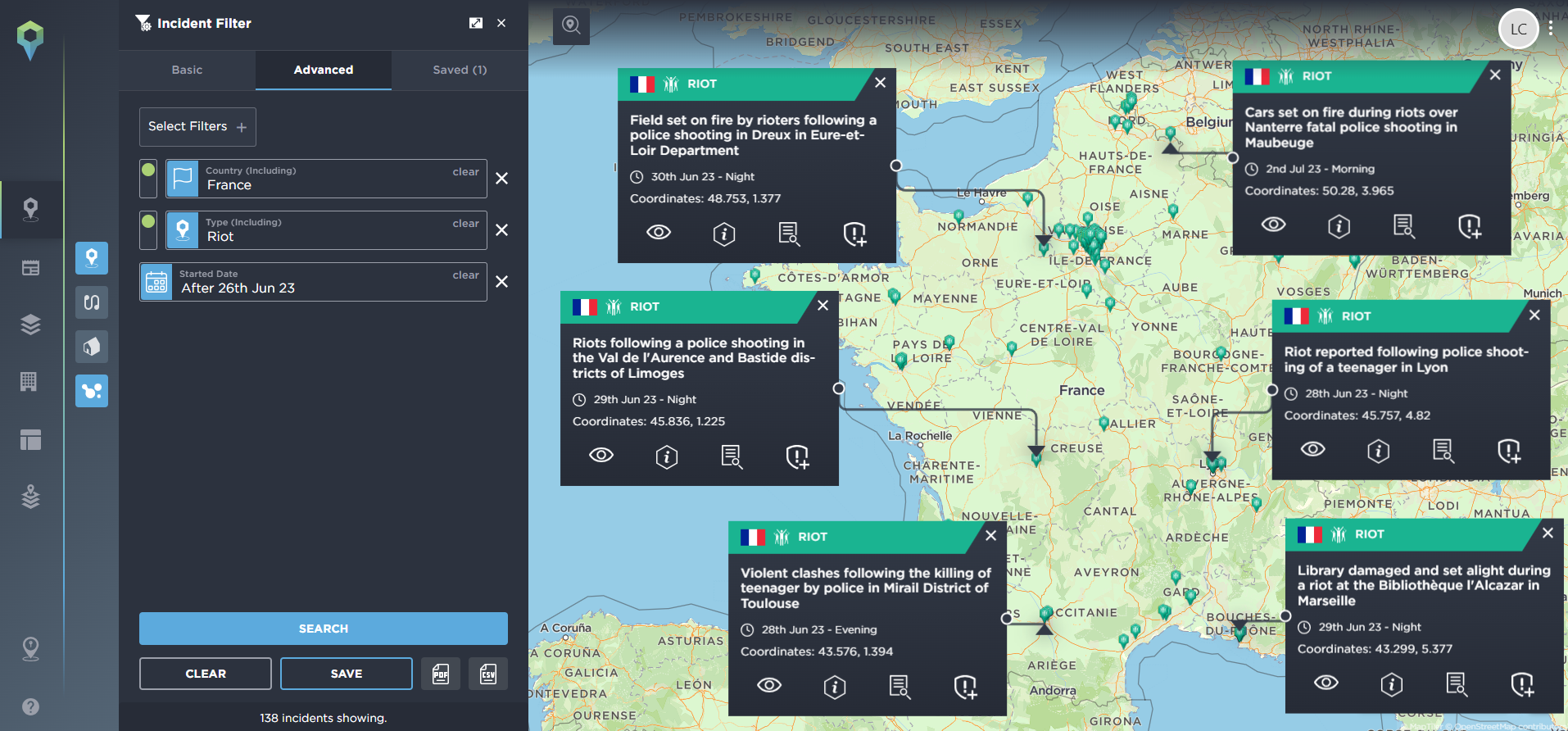
Over 130 instances of rioting mapped across France since the 27th of June [Image Source: Intelligence Fusion]
What exactly happened?
On 27th June, a 17-year-old boy was shot at a close range during a traffic stop near Place Nelson Mandela in the Paris suburb of Nanterre. The victim, later identified as Nahel Merzouk of North African origin, died at the scene. Violent riots erupted on the same night in the area, which then spread across the Île-de-France region and across the country.
Following almost a week of daily unrest and violence that resulted in hundreds of injuries and extensive damages, the situation has started to calm down since Sunday night.
Whilst the intensity of the unrest has died down, more isolated riots are likely to continue to happen in the country for at least the next few days. Peaceful and organised demonstrations against police brutality and discrimination are very likely to occur on a regular basis in the next few weeks.
What do we know?
Police said that Nahel Merzouk refused to stop after officers attempted to pull him over for speeding. The two officers involved in the shooting claimed that the victim drove towards them, and were in grave danger when one of the officers opened fire. However, eyewitnesses and video footage contradicted that version of events. The footage shows the two officers standing by the side of the driver’s window of the stopped car as one of them is pointing a gun at the driver. A voice is heard in the footage saying, “You are going to get a bullet in the head”. The officer then opens fire as the car moves past him. The prosecutor’s office has charged the officer with voluntary homicide after concluding that the police use of a firearm during the incident did not meet the legal standard. The contradiction between the officers’ statements and the footage, as well as the nationality of the victim, which many believed was a contributing factor, have fuelled anger and the already prominent distrust towards authorities, especially in the multi-racial suburbs.

146 incidents directly linked to the Nanterre fatal police shooting [Image Source: Intelligence Fusion]
What impact has the rioting and unrest had across France?
Riots started in the area near the fatal shooting, and clashes broke out between protesters and police as fires were set and fireworks were thrown. The riots quickly spread around the Île-de-France region and were initially mainly concentrated in the northwest suburbs of Paris around Nanterre. The riots then spread to central Paris and several cities across the country, including Lille, Nantes, Bordeaux, Toulouse, Marseille, Lyon and Strasbourg. Riot police deployed tear gas and fired rubber bullets to disperse the crowds. Several people were reportedly injured by police and a journalist was assaulted by officers while trying to cover the riots.
Supermarkets, shopping centres and other businesses were vandalised, torched and looted. Cars, trams, buses, libraries and schools were set on fire. Several town halls and police stations were also attacked and set on fire, while rioters attacked police with fireworks and Molotov cocktails. On 29th June, 40,000 police and gendarmes were deployed to Paris and the suburbs to respond to the riots. The Mayor of Saint-Denis requested all businesses to remain closed during the night, while the French Interior Minister called for the suspension of bus and tram services after 9pm. On 1st July, the French Interior Minister announced the mobilisation of 45,000 more police officers nationwide. In the last couple of days, incidents of vigilantism have been reported, with armed citizens patrolling the streets to protect their cars or property from rioters. As of the time of reporting, more than 3,300 people have been arrested since the riots erupted, over 1,000 buildings have been damaged, 5,000 vehicles have been burnt, and around 750 police officers have been wounded.
A significant attack took place in L’Haÿ-les-Roses on the early morning of 2nd July when a ram-raid attack targeted the house of the mayor. The suspects drove a car through the gates of the Mayor of L’Haÿ-les-Roses Vincent Jeanbrun’s home before setting the vehicle on fire. The wife and two children of the mayor were inside the house sleeping at the time of the ram-raid. They were attacked with firework rockets by the suspects as they tried to flee the home, and the wife and one of the children sustained injuries. The incident is treated by police as attempted murder, but no arrests have been made at the time of this report. The attack is believed to be connected to the riots.
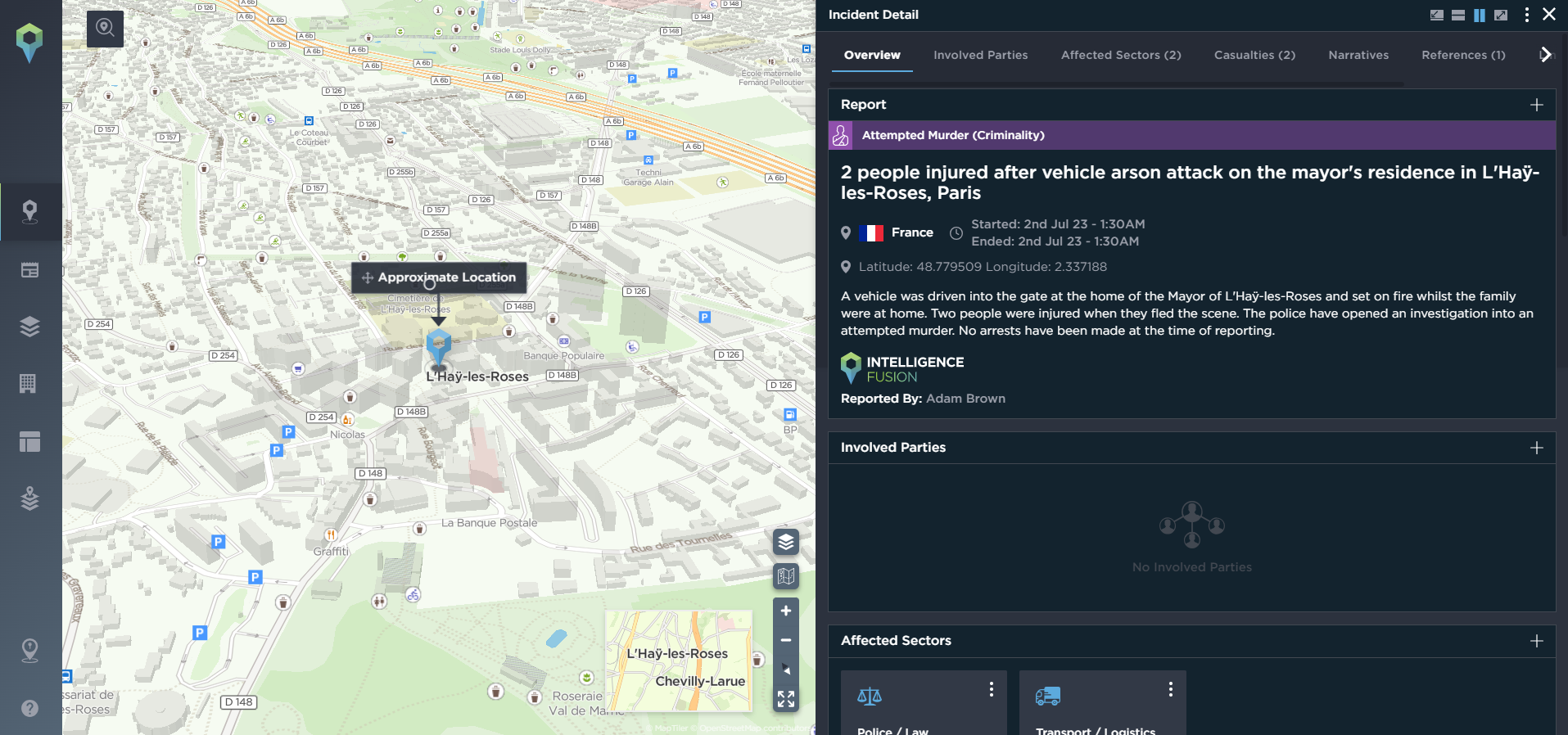
Attempted murder of the Mayor of L'Haÿ-les-Roses, Vincent Jeanbrun and his family [Image Source: Intelligence Fusion]
What is the main motivation behind this unrest?
The protesters ask for justice for the murder of Nahel Merzouk but also want to bring attention to allegations of systemic police abuse, which they claim is prevalent in the working-class suburbs. Protesters claim that police brutality and discrimination are common in lower-income communities and racial minorities. Advocates have also highlighted that there were 13 people killed by police during traffic stops last year, while men of African origin are more likely to be stopped by French police.
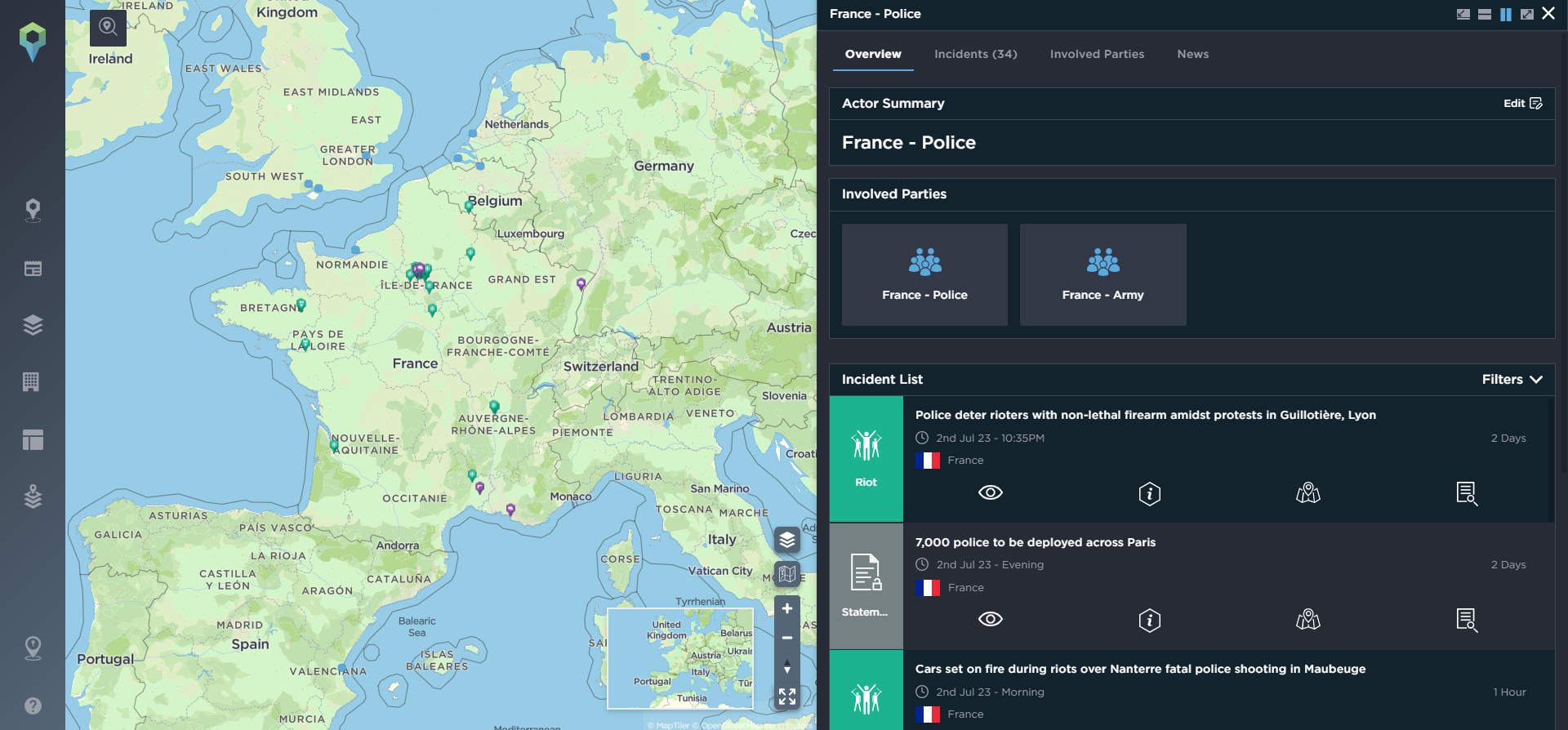
French police, actor profile [Image Source: Intelligence Fusion]
What is the political impact?
While teenagers seem to be responsible for much of the opportunistic vandalism and looting, the more targeted attacks appear to be better organised. Such activity suggests some far-left groups very likely took part in the riots using it as an opportunity to clash with police, while reports indicate that the Black Bloc movement was also involved. The rising anti-government sentiment following the death of Nahel Merzouk as well as the ongoing controversy over the pension reform and the way President Emanuel Macron passed the reform, can likely provide opportunities for far-left groups to gain more support. Meanwhile, the far-right has blamed minorities for the destruction caused during the riots. Reports suggest that far-right groups have been patrolling the streets in Lyon and Chambéry to protect people’s properties against rioters. As grievances are mounting, there is the potential for far-left and far-right groups to gain more popularity, likely deepening the already prominent divisions in French society and politics.
The riots have reduced in the last couple of days, although violence still occurs in the country. The family of Nahel Merzouk has condemned the violence and has asked for peaceful demonstrations, which are very likely to occur on a regular basis in the next few weeks. Related protests, riots or arson attacks are likely to continue to happen sporadically in the country in the near term and unrest in urban areas may cause localised travel disruption due to an increased security presence, road closures and the establishment of checkpoints. There is also a heightened risk to both commercial property and vehicles, with such establishments being targeted for arson and/or looting.
We will continue to monitor the situation, allowing our clients to put preventative measures in place and minimise the impact.
In total, there have been 146 incidents directly linked to the Nanterre fatal police shooting, and this number continues to grow.
We report over 20,000 incidents per month and have over 1,000,000 historical data points on the platform; we are committed to providing the most comprehensive threat intelligence and risk mitigation software to support you and your team.

